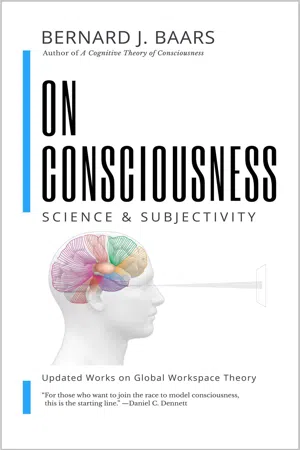
ON CONSCIOUSNESS
Science & Subjectivity - Updated Works on Global Workspace Theory
- English
- ePUB (mobile friendly)
- Available on iOS & Android
ON CONSCIOUSNESS
Science & Subjectivity - Updated Works on Global Workspace Theory
About this book
" The works of Bernard Baars collected here are among the foundational texts of the scientific study of consciousness. Their influence in cognitive science and philosophy of mind is enormous, and their impact on my own thinking has been profound." —Murray Shanahan, Professor of Cognitive Robotics, Dept of Computing, ICL
Global Workspace Theory (GWT) began with this question: “How does a serial, integrated and very limited stream of consciousness emerge from a nervous system that is mostly unconscious, distributed, parallel and of enormous capacity?”
GWT is a widely used framework for the role of conscious and unconscious experiences in the functioning of the brain. A set of explicit assumptions that can be tested, as many of them have been. These updated works, from the recipient ofINNS 2019 Hermann von Helmholtz Life Contribution Award, form a coherent effort to organize a large and growing body of scientific evidence about conscious brains.
Throughout human history, people have perceived the conscious brain as the great nexus of human life, of social relationships, of their personal identities and histories, in encounters with new challenges. Consciousness under its many labels and manifestations is widely seen to be one of the core mysteries of life. Many therapeutic approaches can be viewed in a global workspace framework, including traditional psychodynamics and depth psychology, but also cognitive behavioral techniques, and, indeed, many other kinds of carefully studied human functions. Making progress in understanding consciousness therefore has an endless number of implications - philosophical, metaphysical, scientific, medical, clinical, and practical.
A valuable reference for technical audiences and a vigorous intellectual hike for the layman." — Kirkus Reviews
How can we understand the evidence? The best answer today is a ‘global workspace architecture, ’ first developed by cognitive modeling groups led by Alan Newell and Herbert A. Simon. The term “global workspace” comes from Artificial Intelligence, where it refers to a fleeting memory domain that allows for cooperative problem-solving by large collections of specialized programs. Global Workspace Theory (GWT) therefore assumes that the brain can be viewed as a "society of mind."
Global Workspace (GW) theoryis consistent with our current knowledge, and can be enriched to include other aspects of human experience.
- Stan Franklin and co-workers have built on GWT to sketch out a more general theory of cognition -LIDA: Cognitive Architecture's Computational Implementation of GWT.
- Stanislas Dehaene and Jean-Pierre Changeux in Paris developed experimentally testable models, making further testable claims about the brain basis of visual consciousness - The Dehaene-Changeux Model (DCM): Global Neuronal Workspace is Part of GWT.
Frequently asked questions
- Essential is ideal for learners and professionals who enjoy exploring a wide range of subjects. Access the Essential Library with 800,000+ trusted titles and best-sellers across business, personal growth, and the humanities. Includes unlimited reading time and Standard Read Aloud voice.
- Complete: Perfect for advanced learners and researchers needing full, unrestricted access. Unlock 1.4M+ books across hundreds of subjects, including academic and specialized titles. The Complete Plan also includes advanced features like Premium Read Aloud and Research Assistant.
Please note we cannot support devices running on iOS 13 and Android 7 or earlier. Learn more about using the app.
Information
PART I.
Consciousness Explored: Making sense of the evidence
Introduction
What is the silliest claim ever made? The competition is fierce, but I think the answer is easy. Some people have denied the existence of consciousness: conscious experience, the subjective character of experience, the “what-it-is-like” of experience.
— Galen Strawson, Professor, Department of Philosophy, University of Texas at Austin.
“Men ought to know that from the brain, and from the brain alone, arise our pleasures, joys, laughter and jests, as well as our sorrows, pains, griefs and tears. Through it, in particular, we think, see, hear and distinguish the ugly from the beautiful, the bad from the good, the pleasant from the unpleasant... I hold that the brain is the most powerful organ of the human body... wherefore I assert that the brain is the interpreter of consciousness…” (School of Hippocrates: On the Sacred Disease.)
When it comes to conscious experience, there’s a rock-bottom sense in which we’re fully acquainted with it just in having it. The having is the knowing. So when people say that consciousness is a mystery, they’re wrong — because we know what it is. It’s the most familiar thing there is — however hard it is to put into words.…What people often mean when they say that consciousness is a mystery is that it’s mysterious how consciousness can be simply a matter of physical goings-on in the brain. But here, they make a Very Large Mistake, in Winnie-the-Pooh’s terminology—the mistake of thinking that we know enough about the physical components of the brain to have good reason to think that these components can’t, on their own, account for the existence of consciousness. We don’t.

Conscious experiences
Table of contents
- Cover
- Praise for ON CONSCIOUSNESS
- Title Page
- Updated Works on Global Workspace Theory
- Contents
- Dedication
- Author’s Note
- Epigraph
- Cortex is the organ of mind.
- Half Title
- Epigraph
- PART I.
- PART II.
- PART III.
- Glossary and guide to theoretical claims
- Conscious Access Themes
- PART IV
- Acknowledgments
- About the Author
- Also by BERNARD J. BAARS
- Notes
- References
- Copyright
- Extended Credits
- Illustration & Image Credits